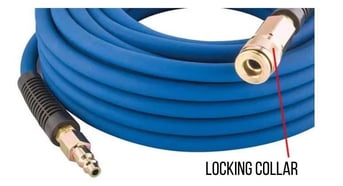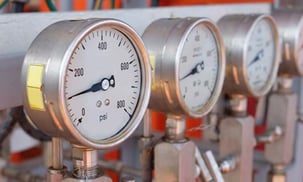As stated in our safety & maintenance of your portable air compressor blog, when operating your compressor, you must be extremely vigilant and handle with care. Once you have completed all your pre-use checks you are good to go. This article will give you our top tips when operating your air compressor.
Positioning and Setup
When positioning your compressor, ensure it sits on level ground with sufficient air flow surrounding. The better the air flow, the more efficiently your machine can run as it is able to both cool off and compress air effectively. This is also the case with hoses, make sure there are air hose is unravelled properly with no kinks which would restrict the airflow. Next connect the female end of the hose (the metal attachment with the hole in) to the male connector on the compressor. There should be a locking collar that clicks over the male connector to ensure a safe and secure connection. In a similar fashion, connect your tool to the compressor making sure safety features have been locked. Before you begin using, double check that the pressure release valves and any drains are closed. Now you’re ready to turn on the machine.

Building up Pressure
Once you have plugged in the compressor and switched it on, you will notice the pressure gauge increases as the stored pressure builds. When the tank is full, it will automatically shut-off. If this automatic switch off does not happen, immediately turn off at the mains and seek support from manufacturer or CES’s servicing team. The pressure gauge is the window to what is happening inside the tank so is important to observe. You’ll note there are two gauges, one for the pressure in the tank and another for the pressure running out the tank to your tool. Always check the operating pressure for your tool or machine and adjust the pressure regulator valve to match the tool. Exceeding the specified pressure can cause damage to your tool and the compressor. The operating pressure is always measured in PSI (pounds per square inch).

After Use
It is good practice to keep your machine tidy so it is kept in good working order, this includes disconnecting all parts, winding up hoses so they are not damaged by weather or walked over and storing all parts correctly in a protected area. Ensure you turn off the machine at the mains as well as turning off the regulator valve so no more air travels into the hose. Always run the tool/machine until the air tank is empty. Carefully disconnect the tool and hoses. Next drain off the unused pressurised air. Though most compressors naturally eject the air once the machine is switched off, it’s important to check this and if not expelled, manually release the air through the pressure release valve. You should gradually turn this valve, twisting slowly until you hear a hiss; any sudden release of pressurised air can be dangerous. Finally remove any moisture build-up through the valve on the compressor.
Compressors at CES
We have a variety of compressors available at CES for hire and purchase and we recommend/offer compressors that are compactible with specific plastering and rendering machines. For further information take a look at the selection available on our website to hire or buy. Alternatively give us a call and we can advise you on the best compressor for your machine.
